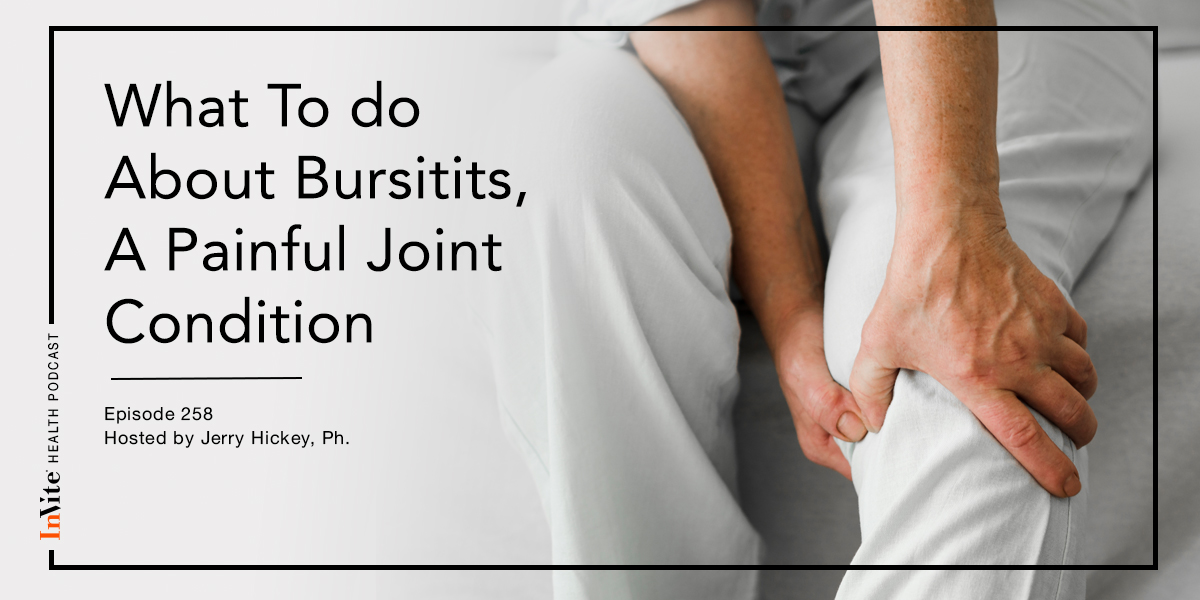What To do About Bursitis, A Painful Joint Condition – InVite Health Podcast, Episode 258

bursitis
Invite Health Podcast, Episode hosted by Jerry Hickey. Ph
Subscribe Today!
Bursitis is a painful condition near your joints. It has to do with these small, squishy, fluid-filled sacs called bursa. Bursa cushion the bones, tendons, muscles and skin near your joints. This prevents rubbing between your bones, tendons, muscles and skin. When they’re injured or they’re overused, like if you’re playing tennis and you have that repetitive tough motion, the bursa can collect extra fluid because they got inflamed. Over time, their walls may thicken and it can be quite painful and disruptive for your lifestyle. When the sacs get inflamed around your joints, they may feel stiff and they can hurt to move the joint in a normal way. It’s linked to certain injuries and diseases, however the cause of your case may be unclear.
What causes Bursitis?
The most common causes of bursitis are repetitive motions or positions that put pressure on the bursa around the joints, like throwing a baseball, lifting something over your head repeatedly, painting your ceiling, leaning on your elbows for a long time and extensive kneeling. Sports that repeat the same motion are a common cause, like tennis. It could also be caused by a bacterial infection. That’s nasty and you really have to see a doctor. Diabetes is connected to an increased risk and so is the blood issue gout, where you build up uric acid crystals in your blood. Arthritis, especially rheumatoid arthritis or psoriatic arthritis, injury from a fall and also walking style may be connected. If you have an uneven gait, like if one leg is shorter than the other, this may contribute to bursitis.
Don’t Accept Joint Pain As A Regular Part of Aging – InVite Health Podcast, Episode 220. Listen Now >>
Symptoms vary, depending on where the bursitis is affecting you. You might feel achy and stiff at the joint. It’ll hurt more when you move it or press on it. It’ll look swollen and red. If it hurts directly around the joint when you move or bend it, it could be a sign of acute bursitis. That’s bursitis that comes on fairly rapidly. Pain levels vary according to the type of bursitis.
Tune into the full podcast episode to learn more about the various symptoms and types of bursitis.

Treatment of Bursitis
There are lifestyle changes that can protect your bursa. First of all, you have to avoid motions that are going to cause pain, because pain is a warning from the body that something’s wrong. If you’re using your knees, use pads or cushions to protect your knees or your butt if you sit or kneel a lot. Get socks that are highly insulated, like the socks they use for running or tennis, because that gives you extra cushioning. You can put cushions in your shoes. You can get pads to protect your elbows so that fluid doesn’t build up again.†
You can use ice or heat. Ice can help get rid of the pain. Never ice for more than 22 minutes because then it becomes negative. This is especially for areas closer to the surface of the skin like the kneecap, heel and elbow. For deep bursitis in your shoulder, inner knee or hip, heat might work better. Apply the ice to reduce the swelling for the first 48 hours, especially after symptoms occur and, once again, no more than 22 minutes at a shot. Apply dry or moist heat, such as a heating pad, or you can take a warm bath.†
Maintain a healthy weight. Being overweight really places a lot more pressure and stress on your joints. Every pound puts two pounds of pressure on your knee joint when you’re walking and it’s worse when you’re running. If you’re 50 pounds overweight, with every step, you’re putting an extra 100 pounds of pressure on your knees. The best remedy if you have arthritis in your knees is losing weight, but if you have bursitis in your legs, you also want to lose that extra weight.†
The Power of Glucosamine & Chondroitin For Joint Health Support – InVite Health Podcast, Episode 194. Listen Now >>
Exercise strengthens your muscles and helps protect your affected joint. Warming up and stretching before stretching, as well as physical therapy, are very important. Physical therapy will help strengthen the muscles and tissues around the affected joint and help prevent future damage.†
There are herbs that help a great deal with inflammation, the first one being the turmeric plant. Turmeric is poorly absorbed, so you want to get a turmeric with improved absorption, like the Curcumin Blend with Bioperine or the BioCurcumin. Those are better absorbed curcumins. You want to get the full plant. Everyone talks about curcumin, but curcumin is only one of the ingredients from the turmeric plant. Boswellia serrata is an herb known as frankincense that has ingredients in it that are great for inflammation in the body. Perna canaliculus is a green mussel that is very high in fish oil-type fatty acids, but it has some additional fatty acids that you don’t get in a regular fish oil capsule that are terrific for pain and inflammation.†
Learn more about methods for treating bursitis by listening to the full podcast episode.
Thank you for tuning in to the Invite Health Podcast. You can find all of our episodes for free wherever you listen to podcasts or by visiting www.invitehealth.com/podcast. Make sure you subscribe and leave us a review! Follow us on Facebook, Twitter and Instagram at Invite Health today. We’ll see you next time on another episode of the Invite Health Podcast.

